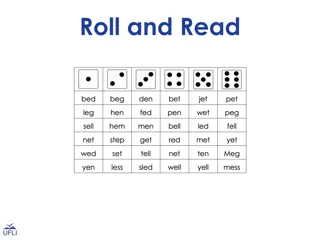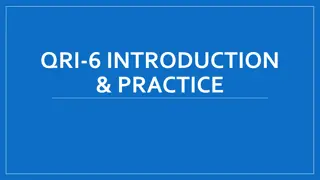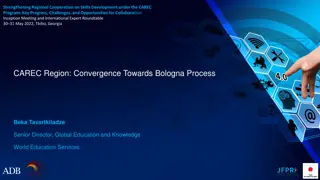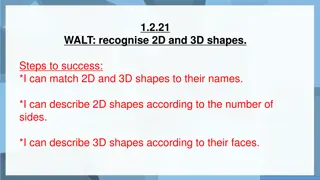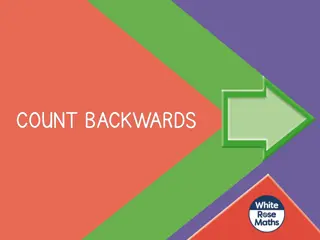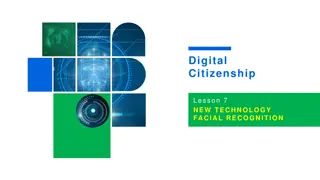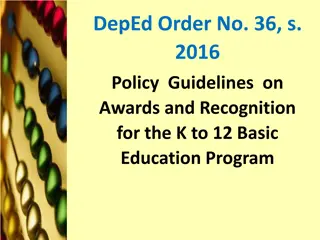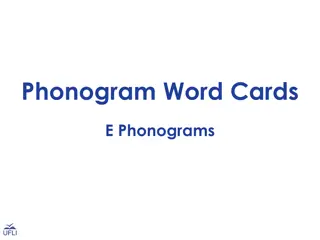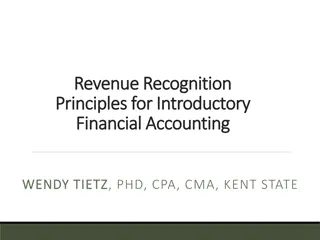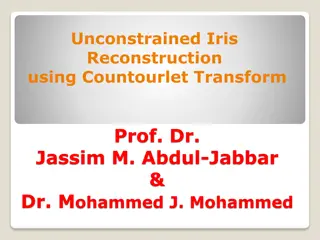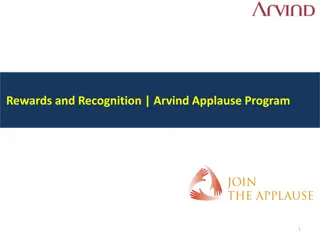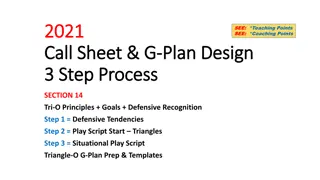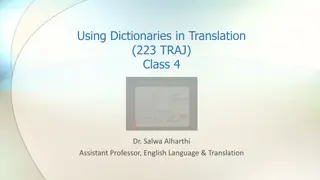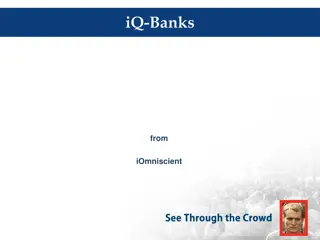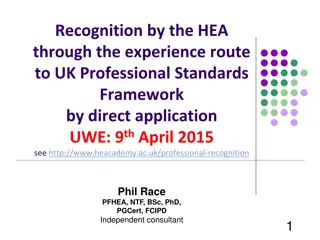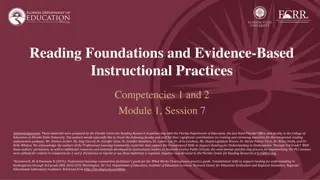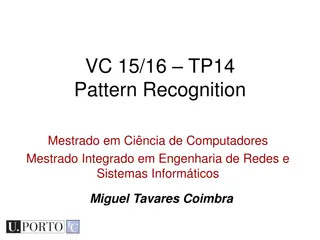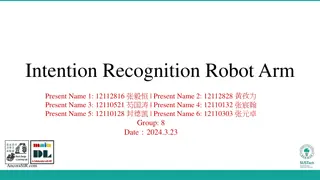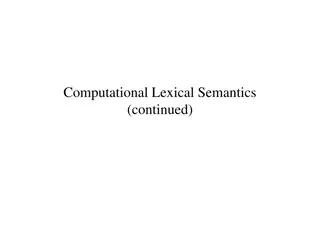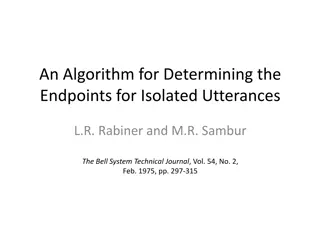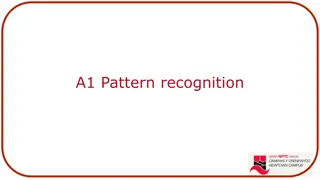Employee Recognition
Learn the importance of recognizing employee achievements to motivate and retain top talent. Explore various recognition methods and their impact on employee performance and company success. Discover tips and examples to implement an effective recognition program. Popular
0 views • 22 slides
Exploring AGImageAI: Enhancing Image Recognition with Artificial Intelligence
AGImageAI, developed by AlpineGate, is a cutting-edge image recognition software leveraging AI techniques to analyze various industries. AlpineGate, based in San Francisco, specializes in innovative solutions for image interpretation. Albert, the AI assistant, provides helpful information to users,
22 views • 21 slides
Energy Wheel & Hazard Recognition Toolbox Talk
Hazard recognition is crucial for safety in all activities. Hazards can range from gravity and motion to mechanical and chemical risks. Failure to identify hazards can lead to incidents, making tools like the Energy Wheel key for improving recognition. The Energy Wheel enhances hazard recognition by
2 views • 10 slides
Unveiling the World of Facial Recognition Technology
Explore the world of facial recognition technology and delve into its benefits, risks, and impact on privacy. Understand key vocabulary, essential questions, and learning objectives surrounding this AI technology. Dive into discussions on unlocking devices with facial recognition and ponder the impl
0 views • 21 slides
Fun Word Reading Practice with Roll and Read Activities
Engage students in a fun word reading practice with Roll and Read activities. These activities involve rolling a die and either reading words or marking them based on the number rolled. Options are provided for different target concepts such as short vowels and CVCe words. Use this interactive metho
1 views • 10 slides
Reading Assessment Guidelines for Students
Begin the reading assessment by starting with word lists below the student's grade level placement. Progress through word lists, evaluating accuracy and response time, to determine the student's reading level. Consideration should be given to decoding ability, recognition of patterns, and comprehens
0 views • 17 slides
Advancing Regional Cooperation on Skills Development in the CAREC Program
Strengthening Regional Cooperation on Skills Development under the CAREC Program is crucial for progress in the region. Challenges and opportunities for collaboration were discussed at the Inception Meeting and International Expert Roundtable in Tbilisi, Georgia. With 48 years of expertise, World Ed
0 views • 14 slides
Shapes Recognition Activities for Students
Explore various 2D and 3D shape recognition activities including matching shapes to names, identifying shapes based on sides and faces, and sorting shapes into categories. Engage in fluency exercises to name and match shapes, reasoning challenges, and problem-solving tasks to enhance shape recogniti
0 views • 12 slides
Understanding the Importance of Different Edge Types in Image Recognition
This content delves into the significance of various edge types in image recognition, exploring the impact of edges such as albedo, depth, surface normal, and shadow on the recognition process. Researchers have studied the effects of different edge types through works dating back to the 1960s, aimin
0 views • 31 slides
Counting and Number Recognition Activities
Engage in a variety of counting and number recognition activities, including identifying numbers, counting backwards, and identifying missing numbers on number tracks. These fun exercises encourage children to practice their counting skills and improve their number recognition abilities.
0 views • 13 slides
Exploring Facial Recognition Technology in Digital Citizenship
Dive into the world of facial recognition technology with a focus on digital citizenship. Learn about its benefits, risks, trends, and potential invasion of privacy. Delve into discussions on the use of facial recognition in various devices and its implications for security and convenience, using re
0 views • 11 slides
Spectroscopy and Pattern Recognition in Pharmaceutical Analysis
Understanding spectroscopy and pattern recognition in pharmaceutical analysis is crucial for interpreting 1H NMR spectra. Specific splitting patterns indicate the presence of various functional groups like ethyl, isopropyl, and tert-butyl. Recognizing these patterns aids in identifying compounds eff
3 views • 51 slides
Automatic Recognition of Higher Education Qualifications Treaty Summary
Importance of automatic recognition of qualifications in higher education has been emphasized, leading to initiatives like the Treaty on Automatic Recognition of Higher Education Qualifications by Baltic and Benelux states. This treaty aims to enhance mutual trust, transparent recognition, and contr
1 views • 8 slides
Tactical Field Care - Shock Recognition and Management
Tactical Field Care emphasizes the importance of shock recognition and prompt intervention to prevent casualties on the battlefield. Understanding the signs, symptoms, and management steps of shock, particularly in trauma cases with life-threatening bleeding, is crucial for medical personnel. This m
0 views • 18 slides
Enhancing Learning Through Awards and Recognition Programs
This policy guideline emphasizes the importance of awards and recognition in creating a positive learning environment, boosting student morale, and motivating high performance. It focuses on providing equal opportunities for learners to excel, recognizing their unique strengths, and promoting studen
0 views • 53 slides
Phonogram Word Cards for Teaching Phoneme-Grapheme Correspondences
Explore a collection of phonogram word cards featuring various phoneme-grapheme correspondences for educational activities like word sorts and review games. Enhance phonics skills with word lists containing words sharing the same phonogram, covering a wide range of graphemes and phonemes. Utilize th
0 views • 32 slides
Comprehensive Guide for K-2 Reading Intervention
This comprehensive guide for parents of K-2 students outlines effective reading intervention strategies to develop fluent and thoughtful readers. It covers essential elements like word recognition, comprehension, vocabulary, and offers practical activities to enhance word identification, decoding sk
0 views • 24 slides
Understanding Word Meaning in Lexical Semantics
Introduction to Chapter 5 Lecture 4.1 discusses the nature of word meaning, major problems of lexical semantics, and different approaches. It explains the concept of a word, prototypical words, lexical roots, lexemes, and word forms, highlighting the importance of the word as a lexeme in lexical sem
1 views • 20 slides
Revenue Recognition Principles for Financial Accounting Overview
Overview of revenue recognition principles for introductory financial accounting, highlighting the five-step process: contract identification, performance obligations, transaction price determination, allocation, and revenue recognition. Example provided with L.L. Bean and Michelle Sylvester's trans
0 views • 37 slides
Understanding Levels of Object Recognition in Computational Models
Explore the levels of object recognition in computational models, from single-object recognition to recognizing local configurations. Discover how minimizing variability aids in interpreting complex scenes and the challenges faced by deep neural networks in achieving human-level recognition on minim
0 views • 29 slides
Spelling Practice for Year 3 and Year 4 Students
Improve spelling skills with word lists for Year 3 and Year 4, focusing on nouns created with suffixes -ness and -ment. Engaging exercises with missing word endings to reinforce learning. Enhance vocabulary and word recognition for young learners.
0 views • 44 slides
Enhancing Iris Recognition with Circular Contourlet Transform
Iris recognition is a reliable biometric identification method due to the iris's unique properties. By incorporating the Circular Contourlet Transform (CCT) into the classical iris recognition algorithm, the feature extraction process can be enhanced to improve recognition rates under unconstrained
0 views • 14 slides
Arvind Applause Program: Recognizing Excellence and Loyalty
Explore the Arvind Applause Program, designed to reward and recognize employees through various categories such as Instant Recognition Awards, Value Awards, Long Service Awards, Spotlight Awards, and Retail Awards. Learn how this program reinforces organizational culture, values, and employee motiva
0 views • 9 slides
Exploring Visual Vocabulary Trees for Image Recognition
In this detailed content, the implementation of Vocabulary Trees for image recognition is discussed. The structure's complexity, efficiency in processing a large number of images, and issues related to instance recognition are explored. The text delves into the benefits of using vocabulary trees, ch
0 views • 27 slides
Defensive Recognition and Play Scripting for Offensive Success
Explore defensive recognition strategies by analyzing defensive tendencies based on down, distance, and field zone. Learn how to create effective play scripts using offensive position recognition and Tri-O principles to achieve offensive success. Utilize the no-huddle approach, ANA system, and key c
0 views • 13 slides
Understanding Word Formation and Coinage in English
Word formation in English involves different processes such as compounding, conversion, and derivational affixation. Compounding combines two or more words to create a new word, while conversion changes the word class without affixes. Word coinage includes compounds, acronyms, back-formations, abbre
0 views • 10 slides
Understanding the Role of Dictionaries in Translation
Dictionaries play a crucial role in translation by helping users find information about linguistic signs, word division, spelling, and word formation. The lemma serves as a representative of a lexical item in a dictionary, aiding users in locating specific entries. Word division information can assi
0 views • 12 slides
iQ-Banks Security and Operations Solutions Overview
iQ-Banks offers a range of advanced solutions for ATM security, branch operations, face recognition, and mobile agent communication. These solutions include features such as detecting theft, vandalism, skimming devices, and intrusions, as well as providing access control, license plate recognition,
0 views • 6 slides
Understanding HEA Professional Recognition in the UK Higher Education Sector
Recognition by the Higher Education Academy (HEA) through the experience route to the UK Professional Standards Framework (UKPSF) is a valuable achievement for higher education practitioners. This presentation by Phil Race and Sally Brown highlights the benefits of HEA recognition, the evolving syst
0 views • 79 slides
Foundational Practices for Effective Reading Instruction
These materials were prepared by the Florida Center for Reading Research in collaboration with the Florida Department of Education and faculty from Florida State University. This module emphasizes teaching students to decode words, analyze word parts, and improve word recognition skills. Recommendat
0 views • 21 slides
Understanding Text Similarity Techniques in NLP
Explore various text similarity techniques in Natural Language Processing (NLP), including word order, length, synonym, spelling, word importance, and word frequency considerations. Topics covered include bag-of-words representation, vector-based word similarities, TF-IDF weighting scheme, normalize
2 views • 62 slides
Face Recognition: A Comprehensive Literature Survey
This literature survey delves into the importance and challenges of face recognition technology, covering topics such as biometrics, human face recognition, variations in pose and illumination, early and modern approaches, as well as the evaluation of face recognition systems. The need for face reco
0 views • 30 slides
Tau Beta Sigma Sorority Jewelry Collection - Spring 2013
Explore the exquisite collection of Tau Beta Sigma sorority jewelry, including the Prospective Member Pin, TB Recognition Pin, Enameled Recognition Pin, Crown Pearl Badge, Official Key, Recognition Bar, and Life Member Pin. Each piece holds special significance within the sorority, symbolizing commi
0 views • 11 slides
Understanding Pattern Recognition in Computer Science
Dive into the world of pattern recognition, where data is analyzed to make decisions and identify features. Explore statistical pattern recognition, classifiers, and the process of recognizing patterns in images. Learn how computers see and interpret visual data, and the challenges of representing k
0 views • 43 slides
Assistive System Design for Disabilities with Multi-Recognition Integration
Our project aims to create an assistive system for individuals with disabilities by combining IMU action recognition, speech recognition, and image recognition to understand intentions and perform corresponding actions. We use deep learning for intent recognition, gesture identification, and object
0 views • 14 slides
The Sunday of the Word of God Celebration - 24th January 2021
The Sunday of the Word of God, observed on the 24th of January 2021, is dedicated to the celebration, study, and dissemination of the Word of God. Pope Francis encourages Catholics worldwide to deepen their relationship with God through His Word. The event highlights the importance of valuing both t
0 views • 27 slides
Understanding Word Vector Models for Natural Language Processing
Word vector models play a crucial role in representing words as vectors in NLP tasks. Subrata Chattopadhyay's Word Vector Model introduces concepts like word representation, one-hot encoding, limitations, and Word2Vec models. It explains the shift from one-hot encoding to distributed representations
0 views • 25 slides
Understanding Word Sense Disambiguation in Computational Lexical Semantics
Word Sense Disambiguation (WSD) is a crucial task in Computational Lexical Semantics, aiming to determine the correct sense of a word in context from a fixed inventory of potential word senses. This process involves various techniques such as supervised machine learning, unsupervised methods, thesau
0 views • 67 slides
Algorithm for Determining Endpoints in Speech Recognition
This article discusses an algorithm proposed by L.R. Rabiner and M.R. Sambur in 1975 for determining endpoints in isolated utterances. The algorithm focuses on detecting word boundaries in speech through the recognition of silence, which can lead to reduced processing load and increased convenience,
0 views • 22 slides
Understanding Pattern Recognition in Computational Thinking
Pattern recognition in computational thinking involves identifying common elements, interpreting differences, and predicting based on patterns. It helps simplify complex problems by recognizing similarities and characteristics shared among them. Through repetition and algorithmic processes, patterns
0 views • 6 slides




